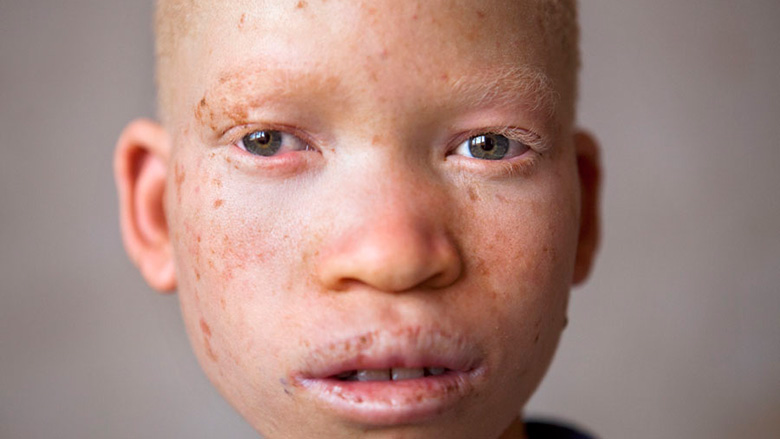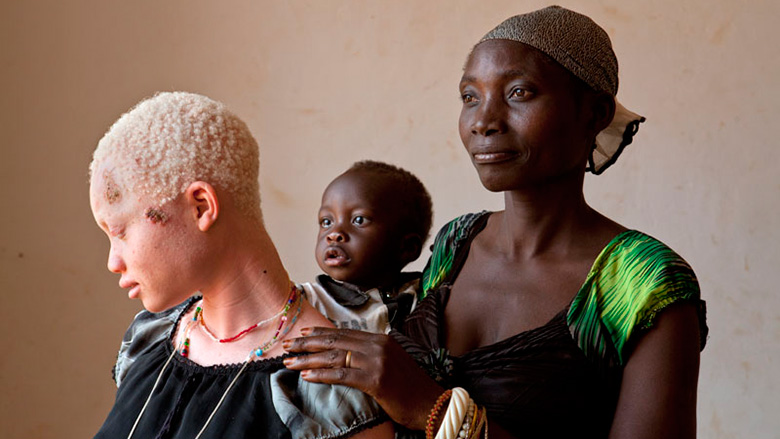They say a picture is worth a thousand words. Each one speaks volumes in the work of photojournalist Jacquelyn Martin. Through her striking portraits, Martin gives a powerful account of the daily struggle faced by people with albinism in Tanzania. But Martin also gives us hope. Take, for example, her portrait of Eumen Ezekiel, a 13-year-old who has a dream: to one day become a Member of Parliament and defend the rights of people living with albinism, a rare genetic condition characterized by lack of skin pigmentation.

Eumen Ezekiel dreams of becoming a Member of Parliament to defend the rights of people living with albinism
Courtesy of Jacquelyn Martin
Charlotte McClain-Nhlapo
In 2012, Martin visited the Kabanga Protectorate Center in the Tanzanian city of Kabanga in the hope of creating portraits to put a human face on the issue. Located in rural Western Tanzania, the center has become a refuge of sort for children with albinism, who are often unable to attend school due to discrimination and fear of attacks: Because of the fairness of their skin, some consider the children “ghosts,” and they have been targeted for ritual killings. At a roundtable discussion addressing the socioeconomic challenges faced by people with albinism, recently hosted by the World Bank, Martin reminded her audience that the people she interviewed during her three-week stay at the center didn’t want to spend their lives parked in government camps. “They want to be integrated, be able to marry, have children and have a life,” she said.
While albinism is a genetic condition inherited from both parents, regardless of ethnicity or gender, the phenomenon remains widely misunderstood. According to data provided by the World Health Organization, estimates of its incidence vary from one in 5,000 to one in 15,000 in sub-Saharan Africa. In Tanzania, by some estimates, one in 19 people carry the genes. Collecting data on people with albinism remains a challenge, as many with the condition are forced to hide in fear of the stigma it carries. It’s also important to realize that albinism is not a uniquely African issue but rather a global health issue. In Europe and North America, one in every 17,000 to 20,000 people also have some form of albinism.
According to Charlotte McClain-Nhlapo, the World Bank’s Global Disabilities Advisor, who organized the roundtable as well as an exhibit of Martin’s photos with the support of Marina Galvani, the World Bank’s art curator to help shine a light on the issue: “This gave us an opportunity to raise the issue of extreme exclusion. We are looking at people who are agents of change, who can contribute to society and, more importantly, who shouldn’t be excluded because they look different.”
In the roundtable discussion, participants highlighted results and solutions. Sajjad Ali Shah, the World Bank country program coordinator for Tanzania, proposed linking the issue more proactively with ongoing World Bank programs in the country. “For example, we have a health program as well as an education program, both designed to improve the access and quality of health and education services in Tanzania. We also have a safety net program,” he said. “When we look at an issue like albinism, we tend to look at it through the lens of our social safeguard policy and say that there shouldn’t be discrimination against people with albinism. We should do much more than that,” he added.
There was also some encouraging news. On June 13, the UN launched the first-ever International Albinism Awareness Day to honor people with albinism and raise awareness of their plight. Shortly after the event, roundtable participant Ikponwosa Ero, a lawyer and advocacy officer at the Canadian NGO Under the Same Sun, was appointed by the Office of the United Nations High Commissioner for Human Rights as the first-ever “independent expert on the enjoyment of human rights by persons with albinism.” Ero noted that on November 28, 2015, the first Pan-African Albinism Conference will take place in Dar Es Salaam with 28 African countries represented, calling it “the largest gathering of this kind.” Another encouraging sign that the rights of people with albinism are slowly being recognized.
Jon Beale, managing director of Standing Voice, a British NGO working to stop human rights violations against marginalized groups, spoke about his association’s work in Tanzania, where, according to estimates, 98 percent of people with albinism die before the age of 35 due to skin cancer. Beale also had some good news to share. Standing Voice and partner organizations distribute sunscreen (made in Kilimanjaro), protective clothing, wide-brimmed hats, and vital information about skin cancer risks and prevention to people with albinism. In some regions of Tanzania targeted by this program, incidence of skin cancer has dropped by 83 percent.


